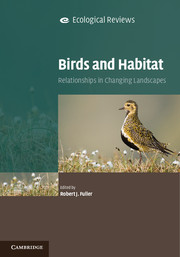Book contents
- Frontmatter
- Contents
- List of Contributors
- Preface
- Part I The complexity of patterns and processes
- Part II Case studies of habitat use and selection
- Part III Wider perspectives
- Chapter Fifteen What is habitat quality? Dissecting a research portfolio on shorebirds
- Chapter Sixteen Understanding individual life-histories and habitat choices: implications for explaining population patterns and processes
- Chapter Seventeen Insufficient adaptation to climate change alters avian habitat quality and thereby changes habitat selection
- Chapter Eighteen Australian birds in a changing landscape: 220 years of European colonisation
- Chapter Nineteen Birds in cultural landscapes: actual and perceived differences between northeastern North America and western Europe
- Chapter Twenty Birds and their changing habitat: thoughts on research and conservation strategies
- Species index
- Subject index
- References
Chapter Sixteen - Understanding individual life-histories and habitat choices: implications for explaining population patterns and processes
Published online by Cambridge University Press: 05 December 2012
- Frontmatter
- Contents
- List of Contributors
- Preface
- Part I The complexity of patterns and processes
- Part II Case studies of habitat use and selection
- Part III Wider perspectives
- Chapter Fifteen What is habitat quality? Dissecting a research portfolio on shorebirds
- Chapter Sixteen Understanding individual life-histories and habitat choices: implications for explaining population patterns and processes
- Chapter Seventeen Insufficient adaptation to climate change alters avian habitat quality and thereby changes habitat selection
- Chapter Eighteen Australian birds in a changing landscape: 220 years of European colonisation
- Chapter Nineteen Birds in cultural landscapes: actual and perceived differences between northeastern North America and western Europe
- Chapter Twenty Birds and their changing habitat: thoughts on research and conservation strategies
- Species index
- Subject index
- References
Summary
Prologue
The restoration of grey wolves Canis lupus to the Yellowstone ecosystem is one of the largest and best-monitored experiments addressing links between individual habitat use and processes at the population level. After some 70 wolf-free years, 31 wolves were released in 1995–1996, so that Yellowstone again hosts all native large carnivores. Although large efforts to predict the ecological effects of wolves had been made on the basis of extant evidence, models and expert knowledge (Mack and Singer, 1992; Boyce, 1993; Cook, 1993) no one expected that these few individuals would change so much of the ecosystem. After only a decade the re-introduction has given rise to manifold ecological changes. Many of these are related to individual behaviour of the new predator or individual responses of potential prey. Proximate impacts, such as predation on elk Cervus elaphus, the main prey, were as predicted (Boyce, 1993; Smith et al., 2003). It was a surprise, however, that the re-introduction of a top predator would so quickly influence Yellowstone’s vegetation. The presence of wolves had profound effects on the trophic web, operating remarkably fast and reaching down to primary production. Interestingly, these effects were mainly related to behavioural processes (such as habitat use and spatial distributions) rather than to demographic processes (for example, population sizes and survival rates) due to predation. How did these relatively few wolf individuals cause so many changes at various levels of the ecosystem? Primarily, as an anti-predator response, elk altered their habitat selection and use of resources. Simultaneous GPS tracking of wolves and elk revealed that the elk responded to the presence of wolves at a distance of up to 1 km. They moved into wooded areas, avoiding the open grassland (Creel et al., 2005). The vegetation responded quickly to the resulting relief from browsing, and various plant species re-colonised areas from which they were absent for decades, for example willows Salix spp. and aspen Populus spp. (Ripple et al., 2001; Ripple and Beschta, 2006; Beyer et al., 2007).
Information
- Type
- Chapter
- Information
- Birds and HabitatRelationships in Changing Landscapes, pp. 408 - 431Publisher: Cambridge University PressPrint publication year: 2012
References
Accessibility standard: Unknown
Why this information is here
This section outlines the accessibility features of this content - including support for screen readers, full keyboard navigation and high-contrast display options. This may not be relevant for you.Accessibility Information
- 1
- Cited by
